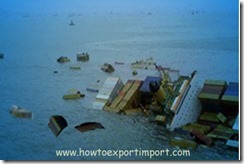
The information provided here is part of Online Training Course on howtoexportimport
This article is a continuation of my article - Consequences of wrong declaration of weight If you have not read the first part of this article, please click here to read Consequences of wrong declaration of weight Part 1.
When a booking is accepted, the shipper advises the shipping line the estimated cargo weight. Once after accepting cargo from shipper, the carrier moves cargo to load port and if terminals weighs the cargo, the actual weight has to be intimated to the vessel planning authorities for necessary stowage.
Since the overweight of cargo effects the stability of vessel, the stow planning officials of vessel can stop loading such misdeclared overweight cargo. The shipping line can also stop loading container if found weight declared wrongly by shipper.
Inland highway authorities at different states in different countries have different rules and regulations. While booking a cargo for door delivery at destination, the shipper should know such regulations of each destination state or country (or both) pertaining to the weight conditions. If the cargo has been loaded with an excess weight or wrong declared weight, shipping line can switch the transport mode in Bill of lading as ‘port to port’, even though the carrier accepted goods as ‘door delivery’, as the shipper violated the terms and conditions of weight declaration. In such cases, all necessary additional charges with penal charges if any to be paid by the shipper. The carrier also can transfer the excess shipped cargo to another container and the necessary charges has to be born by the customer.
Safety of Life at Sea Convention (SOLAS) is under the process to establish a universal international regulatory requirement on this issue to make confirm on the actual weight of cargo available with the vessel operators before ship stowage planning. The compulsory weighing arrangements are being introduced in due course by authorities to regulate these issues.
Maritime safety has to be maintained by revising maritime regulation with more discipline in declaring weight among all levels of supply chain. Also read Consequences of wrong declaration of weight part 1.
Did you like this article. Pl discuss
The above information is a part of Export import business Course online
Other details on how to import export
Is Letter of Credit LC safe for an Importer?
Is ON BOARD CERTIFICATE required for LC negotiation
What is Rummaging
How does First Appraisement system of import customs clearance procedures work?
How does Letter of Credit work?
How does STP units work in India?
How does TT (Telegraphic Transfer) work?
How does Wire transfer work in international business?
Sea carriers
sea exports
SEZ benefits
Shipping lines worldwide
Short shipment in Export business
Shut out procedures to get back goods to exporter's place
Spelling error in LC? Is wrong spelling a discrepancy under Letter of credit?
Stuffing and De stuffing – 2 regular terms used in shipping
Surrender of Bill of Lading – Some facts
Switch BL
What is the difference between BAF and CAF
What is the difference between High sea sales and imports
What is the difference between re-exports and re-imports
How does First Appraisement system of import customs clearance procedures work?
How does Letter of Credit work?
How does Bill of Lading work in DP payment terms?
How does STP units work in India?
What is VACIS exam in US import customs clearance
The term FCL. What is FCL means
How does a Running bond work?
Travelers to India under import duty exemption, Frequently Asked Questions Part 2
Triangular shipment
Types of Insurance Documents.
What is VACIS exam in US import customs clearance
When can an exporter release bill of lading from shipping company?
When does exporter get EP copy of shipping bill after customs clearance